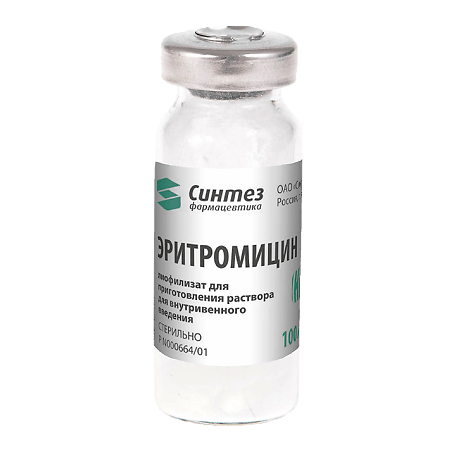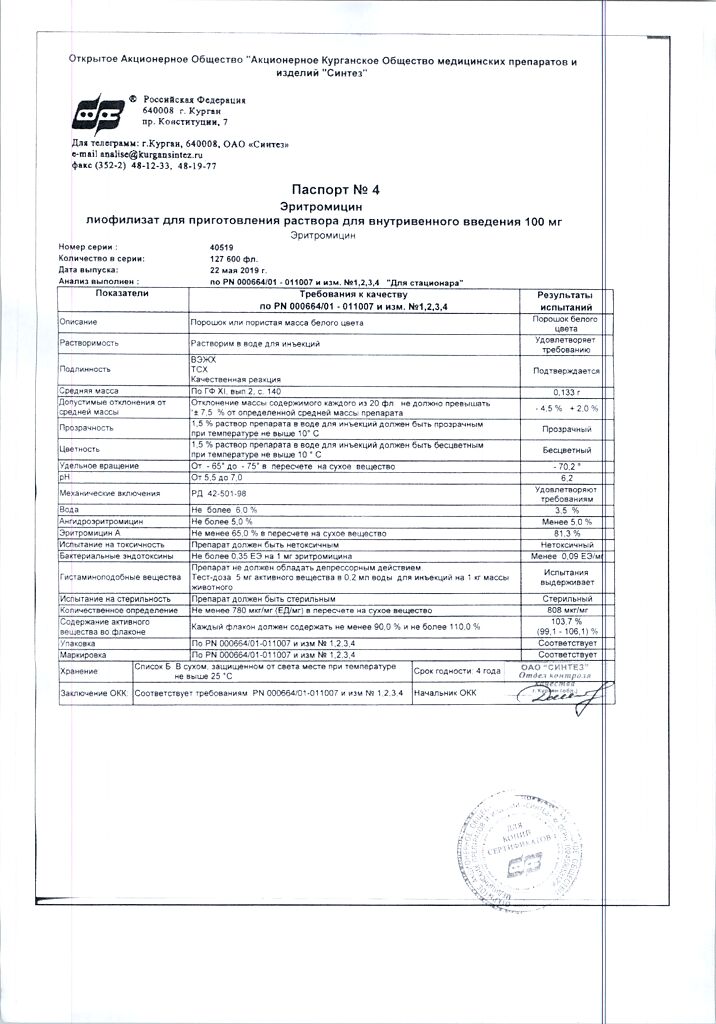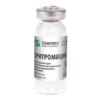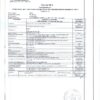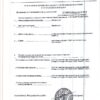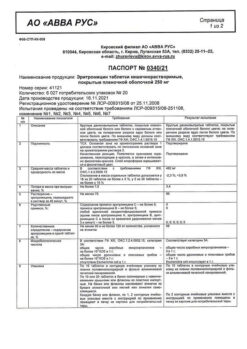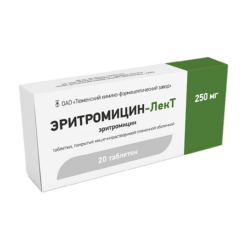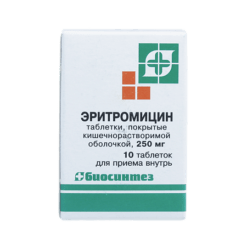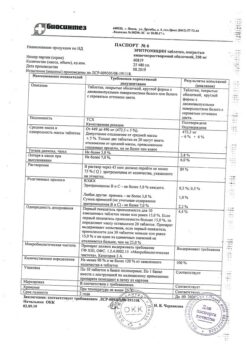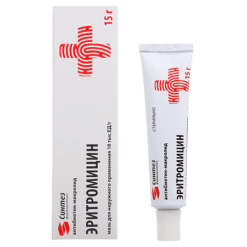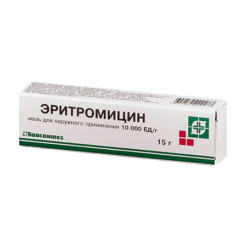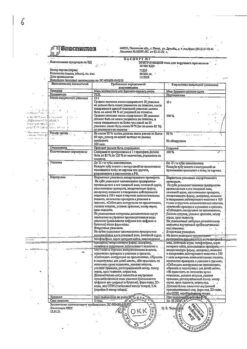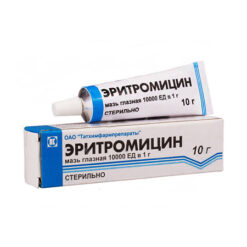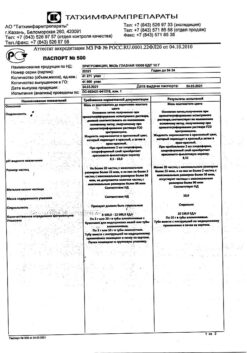No products in the cart.
Erythromycin, lyophilizate 100 mg
€1.11 €0.92
Out of stock
(E-mail when Stock is available)
Description
Pharmacotherapeutic group
Macrolide antibiotic
ATX code: S01AA17
Pharmacodynamics:
The bacteriostatic antibiotic from the group of macrolides reversibly binds to the 50S subunit of ribosomes, which disrupts the formation of peptide bonds between amino acid molecules and blocks protein synthesis of microorganisms (does not affect nucleic acid synthesis). When used in high doses depending on the type of pathogen it may show bactericidal effect.
Sensitive refers to microorganisms whose growth is inhibited when the antibiotic concentration is less than 05 mg/l moderately sensitive – 1-6 mg/l resistant – 6-8 mg/l.
The spectrum of action includes:
Gram-positive microorganisms: Staphylococcus spp. producing and non-producing penicillinase including Staphylococcus aureus; Streptococcus spp. (incl. Streptococcus pneumoniae Streptococcus pyogenes) alpha-hemolytic streptococcus (Viridans group) Bacillus anthracis Corynebacterium diphtheriae Corynebacterium minutissimum;
Gram-negative microorganisms: Neisseria gonorrhoeae Haemophilus influenzae Campylobacter jejuni Bordetella pertussis Brucella spp. Legionella spp. including Legionella pneumophila and other microorganisms: Mycoplasma spp. (including Mycoplasma pneumoniae) Chlamydia spp. (including Chlamydia trachomatis) Treponema spp. Rickettsia spp. Entamoeba histolytica Listeria monocytogenes.
The following Gram-negative bacilli are resistant to the drug: Escherichia coli Pseudomonas aeruginosa as well as Shigella spp. Salmonella spp. Bacteroides fragilis Enterobacter spp. and others.
Pharmacokinetics:
Time to reach maximum concentration after intravenous administration – 20 min. Binding to plasma proteins – 70-90%. Bioavailability is 30-65%. It is distributed unevenly in the body. It is accumulated in large amounts in liver, spleen and kidney. The concentration in bile and urine is ten times higher than in plasma. It penetrates well into lung lymph node tissues middle ear exudate prostatic secretion sperm pleural cavity ascitic and synovial fluid. Milk of nursing women contains 50% of the plasma concentration. It penetrates poorly through the blood-brain barrier into the cerebrospinal fluid (concentration is 10% of the drug concentration in plasma). In inflammatory processes in the brain membranes their permeability to erythromycin increases slightly.
In intravenous administration of the drug in newborns, its high blood concentrations (on average about 13 mcg/ml) are maintained longer than in older children. The process of concentration decrease is distinctly biphasic: in the first 2 hours it decreases much faster than in the next 10 hours.
It is metabolized in the liver (more than 90%) partially with the formation of inactive metabolites. CYP3A4 CYP3A5 and CYP3A7 isoenzymes are involved in metabolism of the drug.
The elimination half-life is 14-2 h with anuria – 4-6 h. Excretion with bile – 20-30% unchanged by kidneys (unchanged) after intravenous administration – 12-15%.
Indications
Indications
Bacterial infections caused by sensitive pathogens:
– Diphtheria (incl. pertussis, trachoma, brucellosis, legionnaire’s disease, erythrazma, listeriosis, scarlet fever, amoebic dysentery, gonorrhea;
– Genitourinary infections in pregnant women caused by Chlamydia trachomatis;
– Primary syphilis (in patients with an allergy to penicillins), ENT-organ infections (tonsillitis, otitis, sinusitis);
– biliary infections (cholecystitis);
– Upper and lower respiratory infections (tracheitis, bronchitis, pneumonia);
– Skin and soft tissue infections (infected wounds, bedsores, II-III degree burns)., Infectious diseases (infected sores, II and III degree burns, trophic ulcers).
Prevention of infectious complications during medical and diagnostic procedures (including pre-operative colon preparation, dental interventions, endoscopy, in patients with cardiac defects).
Gastroparesis (including gastroparesis after vagotomy surgery, diabetic gastroparesis and gastroparesis associated with progressive systemic sclerosis).
Active ingredient
Active ingredient
Composition
Composition
How to take, the dosage
How to take, the dosage
Intravenously slowly (over 3-5 minutes) or by drip. Intravenous drip administration of the drug is preferred and safer.
The single dose of the drug for adults is 02 g daily 06 g. In severe course of infection daily dose can be increased to 1 g and then the drug is administered 4 times a day (every 6 hours). For children aged 4 months to 18 years, depending on body weight and severity of infection, the dose is 30-50 mg/kg/day (for 2-4 injections); for children in the first 3 months of life, it is 20-40 mg/kg/day. In case of severe infections the dose may be doubled.
For intravenous injection the drug is dissolved in water for injection or 09% sodium chloride solution at the rate of 5 mg per 1 ml of the solvent.
For intravenous drip administration the drug is dissolved in 09% sodium chloride solution or 5% dextrose solution to a concentration of 1 mg/ml and is administered at a rate of 60-80 drops/min. It is administered intravenously for 5-6 days (until clear therapeutic effect) with subsequent transition to oral administration.
In case of good tolerance and absence of phlebitis and periphlebitis the course of intravenous administration can be prolonged up to 2 weeks (not more).
In case of renal insufficiency, there is no need to adjust the dose of the drug.
Interaction
Interaction
Decreases the bactericidal effect of beta-lactam antibiotics (penicillins cephalosporins carbopenems). Increases the concentration of theophylline.
Intravenous administration of erythromycin increases the effect of ethanol (accelerates gastric emptying and reduces the duration of action of ethanol dehydrogenase in the gastric mucosa).
It enhances nephrotoxicity of cyclosporine (especially in patients with concomitant renal failure).
Decreases clearance of triazolam and midazolam and therefore may increase the pharmacological effects of benzodiazepines.
Delays elimination (increases the effect) of methylprednisolone felodipine and coumarin-type anticoagulants.
The risk of rhabdomyolysis increases when co-administered with lovastatin.
Induces bioavailability of digoxin.
Decreases the effectiveness of hormonal contraception.
Drugs that block tubular secretion prolong the elimination half-life of erythromycin.
Drugs which are metabolized in the liver (carbamazepine valproic acid hexobarbital phenytoin alfentanil disopyramide lovastatin bromocriptine) may increase plasma concentrations of these drugs (is an inhibitor of microsomal liver enzymes) when taken simultaneously.
In concomitant use with terfenadine or astemizole, arrhythmias (ventricular fibrillation and torsade de pointes ventricular tachycardia up to fatal) with dihydroergotamine or unhydrogenated ergot alkaloids – vasoconstriction to dysesthesia spasm may develop.
Incompatible with lincomycin clindamycin and chloramphenicol (antagonism).
Special Instructions
Special Instructions
Laboratory measures of liver function should be monitored during long-term therapy.
The symptoms of cholestatic jaundice may develop within a few days after the start of therapy; however, the risk increases after 7-14 days of continuous therapy.
The likelihood of ototoxic effects is higher in patients with renal and/or hepatic impairment and in elderly patients.
Some resistant strains of Haemophilus influenzae are sensitive to simultaneous administration of erythromycin and sulfonamides.
May interfere with the determination of catecholamines in the urine and “hepatic” transaminase activity in the blood (colorimetric determination with diphenylhydrazine).
Contraindications
Contraindications
Side effects
Side effects
Gastrointestinal tract: nausea, vomiting, gastralgia, abdominal pain, tenesmus, diarrhea, dysbacteriosis, rarely – oral candidiasis, pseudomembranous enterocolitis, liver function disorders, cholestatic jaundice, increased activity of “liver” transaminases, pancreatitis. In neonates receiving erythromycin, there is a high risk of pylorostenosis.
Hearing organs: ototoxicity – decreased hearing and/or tinnitus (when used in high doses – more than 4 g/day, usually reversible).
Cardiovascular system: rare – tachycardia, prolongation of QT interval on ECG, atrial fibrillation and/or flutter (in patients with prolonged QT interval on ECG).
Allergic reactions: urticaria, skin rash, eosinophilia, rarely – anaphylactic shock.
Local reactions: phlebitis at the site of intravenous administration.
Overdose
Overdose
Symptoms: nausea diarrhea discomfort in the stomach area; dizziness (especially in patients with hepatic or renal failure); impaired liver function up to acute liver failure rarely – hearing loss.
The treatment: close monitoring of the state of respiratory system (if necessary – carrying out artificial lung ventilation) acid-base state and electrolyte metabolism ECG. Symptomatic therapy should be administered. Hemodialysis peritoneal dialysis and forced diuresis are ineffective.
Pregnancy use
Pregnancy use
Prenatal use of the drug is possible only in cases when the estimated benefit to the mother exceeds the potential risk to the fetus.
If it is necessary to use the drug during lactation, discontinuation of breastfeeding should be considered.
Similarities
Similarities
Additional information
| Shelf life | 4 years |
|---|---|
| Conditions of storage | In the dark place at a temperature not exceeding 25 ºС. Keep out of reach of children. |
| Manufacturer | Sintez OAO, Russia |
| Medication form | lyophilizate |
| Brand | Sintez OAO |
Other forms…
Related products
Buy Erythromycin, lyophilizate 100 mg with delivery to USA, UK, Europe and over 120 other countries.

